Abstract
Quantum error correction (QEC) can overcome the errors experienced by qubits1 and is therefore an essential component of a future quantum computer. To implement QEC, a qubit is redundantly encoded in a higher-dimensional space using quantum states with carefully tailored symmetry properties. Projective measurements of these parity-type observables provide error syndrome information, with which errors can be corrected via simple operations2. The ‘break-even’ point of QEC—at which the lifetime of a qubit exceeds the lifetime of the constituents of the system—has so far remained out of reach3. Although previous works have demonstrated elements of QEC4,5,6,7,8,9,10,11,12,13,14,15,16, they primarily illustrate the signatures or scaling properties of QEC codes rather than test the capacity of the system to preserve a qubit over time. Here we demonstrate a QEC system that reaches the break-even point by suppressing the natural errors due to energy loss for a qubit logically encoded in superpositions of Schrödinger-cat states17 of a superconducting resonator18,19,20,21. We implement a full QEC protocol by using real-time feedback to encode, monitor naturally occurring errors, decode and correct. As measured by full process tomography, without any post-selection, the corrected qubit lifetime is 320 microseconds, which is longer than the lifetime of any of the parts of the system: 20 times longer than the lifetime of the transmon, about 2.2 times longer than the lifetime of an uncorrected logical encoding and about 1.1 longer than the lifetime of the best physical qubit (the |0〉f and |1〉f Fock states of the resonator). Our results illustrate the benefit of using hardware-efficient qubit encodings rather than traditional QEC schemes. Furthermore, they advance the field of experimental error correction from confirming basic concepts to exploring the metrics that drive system performance and the challenges in realizing a fault-tolerant system.
This is a preview of subscription content, access via your institution
Access options
Subscribe to this journal
Receive 51 print issues and online access
$199.00 per year
only $3.90 per issue
Buy this article
- Purchase on Springer Link
- Instant access to full article PDF
Prices may be subject to local taxes which are calculated during checkout



Similar content being viewed by others
References
Shor, P. W. Scheme for reducing decoherence in quantum computer memory. Phys. Rev. A 52, R2493–R2496 (1995)
Nielsen, M. & Chuang, I. Quantum Computation and Quantum Information (Cambridge Univ. Press, 2010)
Devoret, M. H. & Schoelkopf, R. J. Superconducting circuits for quantum information: an outlook. Science 339, 1169–1174 (2013)
Cory, D. et al. Experimental quantum error correction. Phys. Rev. Lett. 81, 2152–2155 (1998)
Knill, E., Laflamme, R., Martinez, R. & Negrevergne, C. Benchmarking quantum computers: the five-qubit error correcting code. Phys. Rev. Lett. 86, 5811–5814 (2001)
Chiaverini, J. et al. Realization of quantum error correction. Nature 432, 602–605 (2004)
Schindler, P. et al. Experimental repetitive quantum error correction. Science 332, 1059–1061 (2011)
Waldherr, G. et al. Quantum error correction in a solid-state hybrid spin register. Nature 506, 204–207 (2014)
Taminiau, T. H., Cramer, J., van der Sar, T., Dobrovitski, V. V. & Hanson, R. Universal control and error correction in multi-qubit spin registers in diamond. Nat. Nanotechnol. 9, 171–176 (2014)
Cramer, J. et al. Repeated quantum error correction on a continuously encoded qubit by real-time feedback. Nat. Commun. 7, 11526 (2016)
Pittman, T. B., Jacobs, B. C. & Franson, J. D. Demonstration of quantum error correction using linear optics. Phys. Rev. A 71, 052332 (2005)
Aoki, T. et al. Quantum error correction beyond qubits. Nat. Phys. 5, 541–546 (2009)
Reed, M. D. et al. Realization of three-qubit quantum error correction with superconducting circuits. Nature 482, 382–385 (2012)
Kelly, J. et al. State preservation by repetitive error detection in a superconducting quantum circuit. Nature 519, 66–69 (2015)
Córcoles, A. D. et al. Demonstration of a quantum error detection code using a square lattice of four superconducting qubits. Nat. Commun. 6, 6979 (2015)
Ristè, D. et al. Detecting bit-flip errors in a logical qubit using stabilizer measurements. Nat. Commun. 6, 6983 (2015)
Haroche, S. & Raimond, J.-M. Exploring the Quantum: Atoms, Cavities, and Photons (Oxford Univ. Press, 2006)
Leghtas, Z. et al. Hardware-efficient autonomous quantum memory protection. Phys. Rev. Lett. 111, 120501 (2013)
Mirrahimi, M. et al. Dynamically protected cat-qubits: a new paradigm for universal quantum computation. New J. Phys. 16, 045014 (2014)
Vlastakis, B. et al. Deterministically encoding quantum information using 100-photon Schrödinger cat states. Science 342, 607–610 (2013)
Sun, L. et al. Tracking photon jumps with repeated quantum non-demolition parity measurements. Nature 511, 444–448 (2014)
Steane, A. M. Error correcting codes in quantum theory. Phys. Rev. Lett. 77, 793–797 (1996)
Braunstein, S. L. & van Loock, P. Quantum information with continuous variables. Rev. Mod. Phys. 77, 513–577 (2005)
Leghtas, Z. et al. Confining the state of light to a quantum manifold by engineered two-photon loss. Science 347, 853–857 (2015)
Fowler, A. G., Mariantoni, M., Martinis, J. M. & Cleland, A. N. Surface codes: towards practical large-scale quantum computation. Phys. Rev. A 86, 032324 (2012)
Wallraff, A. et al. Strong coupling of a single photon to a superconducting qubit using circuit quantum electrodynamics. Nature 431, 162–167 (2004)
Paik, H. et al. Observation of high coherence in Josephson junction qubits measured in a three-dimensional circuit QED architecture. Phys. Rev. Lett. 107, 240501 (2011)
Vijay, R., Slichter, D. H. & Siddiqi, I. Observation of quantum jumps in a superconducting artificial atom. Phys. Rev. Lett. 106, 110502 (2011)
Bergeal, N. et al. Phase-preserving amplification near the quantum limit with a Josephson ring modulator. Nature 465, 64–68 (2010)
Bertet, P. et al. Direct measurement of the Wigner function of a one-photon Fock state in a cavity. Phys. Rev. Lett. 89, 200402 (2002)
Acknowledgements
We thank K. Sliwa, A. Narla and L. Sun for discussions. This research was supported by the US Army Research Office (W911NF-14-1-0011). A.P. was supported by the National Science Foundation (NSF) (PHY-1309996). S.M.G. acknowledges additional support from NSF DMR-1301798. Facilities use was supported by the Yale Institute for Nanoscience and Quantum Engineering (YINQE), the Yale SEAS cleanroom and the NSF (MRSECDMR 1119826).
Author information
Authors and Affiliations
Contributions
A.P. and N.O. performed the experiment and analysed the data. N.O. designed and built the feedback architecture with help from Y.L. under the supervision of R.J.S. and M.H.D. R.H. and P.R. developed the optimal control pulses. M.M., Z.L., L.J., S.M.G. and B.V. provided theoretical support. R.H. and L.F. fabricated the transmon qubit. R.J.S. supervised the project. A.P., N.O., L.F. and R.J.S. wrote the manuscript with feedback from all authors.
Corresponding authors
Ethics declarations
Competing interests
R.J.S., M.H.D. and L.F. are founders and equity shareholders of Quantum Circuits, Inc.
Supplementary information
Supplementary Information
This file contains Supplementary Text and Data including Supplementary Methods, additional references, Supplementary Tables 1-2 and Supplementary Figures 1-11. (PDF 7058 kb)
Rights and permissions
About this article
Cite this article
Ofek, N., Petrenko, A., Heeres, R. et al. Extending the lifetime of a quantum bit with error correction in superconducting circuits. Nature 536, 441–445 (2016). https://doi.org/10.1038/nature18949
Received:
Accepted:
Published:
Issue Date:
DOI: https://doi.org/10.1038/nature18949
This article is cited by
-
Universal control of a bosonic mode via drive-activated native cubic interactions
Nature Communications (2024)
-
Autonomous error correction of a single logical qubit using two transmons
Nature Communications (2024)
-
Encoding a magic state with beyond break-even fidelity
Nature (2024)
-
Generation of a hybrid W entangled state of three photonic qubits with different encodings
Quantum Information Processing (2024)
-
Preparation of maximally-entangled states with multiple cat-state qutrits in circuit QED
Frontiers of Physics (2024)
Comments
By submitting a comment you agree to abide by our Terms and Community Guidelines. If you find something abusive or that does not comply with our terms or guidelines please flag it as inappropriate.



